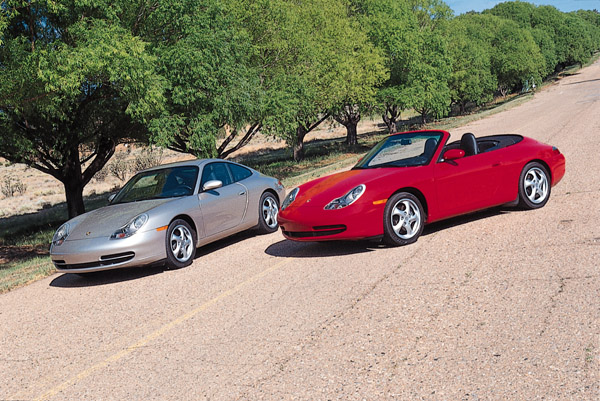
2001 911 Carrera (NA)
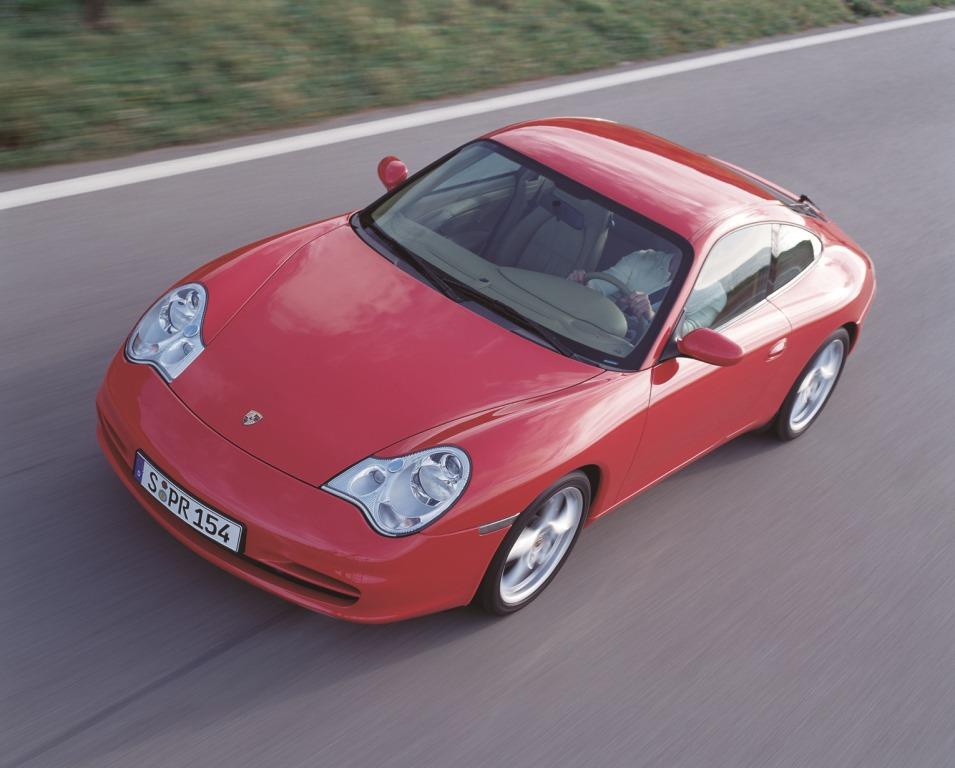
The second generation of the 996 model series Carrera looks far more powerful and dynamic through its newly designed front end. This improvement is attributable above all to the new design of the headlights carried over to the Carrera models from the 911 Turbo. The new front end also spells out more power and dynamism, with the air intake openings being almost completely different from the former design. Two oval tailpipes at the rear and the contour line in the lower third of the rear panel are further clear signs of distinction versus the former model.
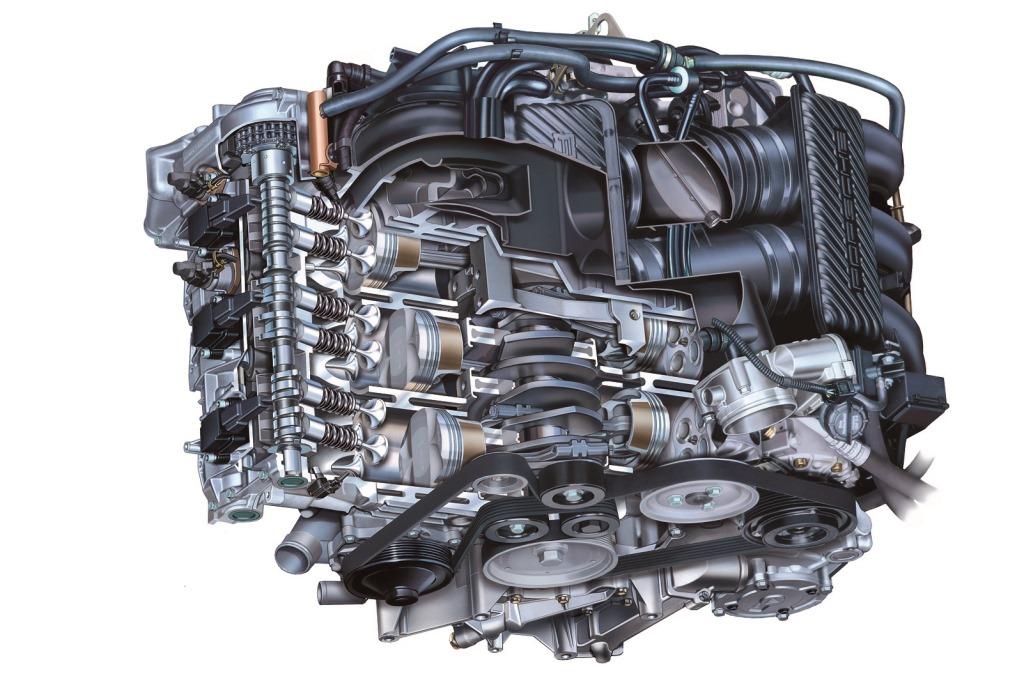
The six-cylinder horizontally-opposed power unit featured in the new Carrera models has been enlarged in size from 3.4 to 3.6 litres by increasing cylinder stroke from 78.0 to 82.8 millimetres (3.07-3.26"). Maximum output is now 235 kW (320 bhp) at 6800 rpm, maximum torque up by 20 Newton metres is 370 Nm or 273 lb-ft at 4250 rpm. Despite this increase in power and torque throughout the entire engine speed range, fuel consumption under the EU standard is down by approximately 6 per cent to 11.1 litres or 25.2 mpg Imp.
VarioCam Plus comprising camshaft adjustment on the intake side and a valve lift switchover function is now also featured on the Carrera models. The valve lift adjustment system is made up of two interacting, switchable cup tappets on the intake side of the engine operated by two cams varying in size on the intake camshaft. The two significant advantages of VarioCam Plus are, first, the optimisation of engine output and torque and, second, the improvement of fuel economy, emission control and motoring refinement.
Porsche's aerodynamicists have given the new Carrera outstanding qualities also in terms of streamlining. First, they have increased the flow of cooling air through the front section by 15 per cent for even better ventilation of the front wheel arches. The second improvement is the significant reduction of lift forces on both the front and rear axle, front-wheel lift being reduced by 25 per cent from cFA = 0.08 to cFA = 0.06, rear-wheel lift by 40 per cent from cRA = 0.05 to cRA = 0.03. A really remarkable point in this context is that the drag coefficient remains unchanged at 0.30 CD.
In their styling the new light-alloy wheels consistently follow the rules of lightweight technology borne out in particular by the very slender spokes. On the 17-inch wheels in 10-spoke design featured as standard, weight is down versus the previous wheels by 9.1 per cent or 3.6 kilos. The difference is even greater on the 18-inch wheels in five-spoke design weighing 10.6 kilos or 23.4 lb less than the former wheels, equal to an improvement by 21.3 per cent.
Apart from detailed modifications such as the red area on the rev counter, the new Carreras come with the same instrument cluster as the 911 Turbo. The lower third of the rev counter arranged right in the middle now houses a large display able to present various messages at the same time. In its basic setting, it presents not only the overall and trip mileage, but also an additional message from the on-board computer such as the outside temperature.
The driver also has the choice of varying the messages displayed as required, the on-board computer now fitted as standard presenting, say, the outside temperature, the range the car is still able to cover on the fuel in the tank, and your current fuel consumption.
Apart from seats finished partially in leather, automatic air conditioning, heat-insulating glass, a cassette radio, electric window lifts, electrically adjustable and heated rear-view mirrors, central locking, an electronic immobiliser and an alarm system with interior surveillance, a three-spoke steering wheel, a new cup holder fitted beneath the centre air nozzle, and an illuminated, lockable glove compartment are now all standard features. The new glove compartment beneath the passenger airbag is able to accommodate books up to the size of a car atlas.
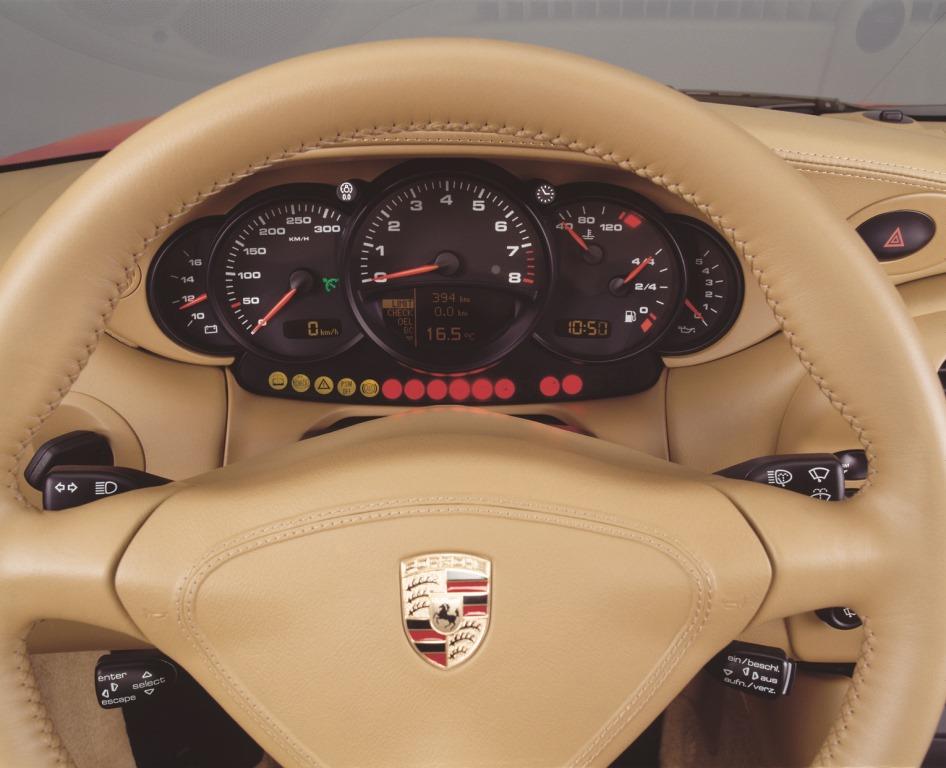
Entering the 2002 model year, the 911 Carrera is moving up a bit closer to the 911 Turbo. As an example, it is receiving the same headlight styling as its “Big Brother" and an entirely new front-end design. Two oval tailpipes at the rear and a contour line in the lower third of the newly designed rear end are further signs of distinction versus the previous model.
Going far beyond a “simple" facelift, Porsche is also presenting a significant innovation within the body of the new model: Enlarged in size to 3.6 litres, the flat-six power unit now develops maximum output of 235 kW (320 bhp), giving the 911 Carrera a top speed of 285 km/h or 177 mph. Acceleration is exactly 5.0 seconds to 100 km/h from a standstill.
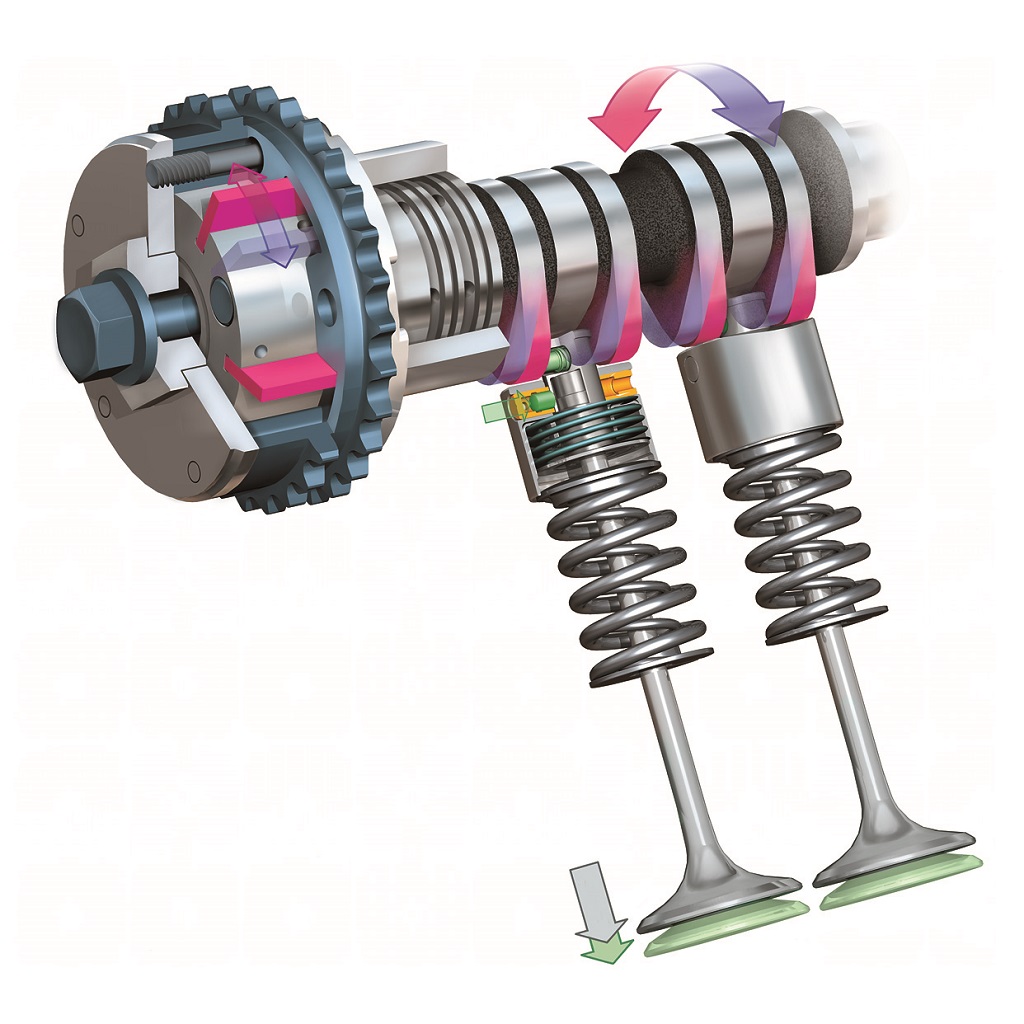
VarioCam Plus is now also featured in the Carrera models. Adding individual valve lift control on the intake side to the VarioCam adjustment of the intake camshaft, this system is made up of switching cup tappets operated by an electrohydraulic 3/2-way switching valve. With various types and contours of cams on the intake camshaft, the cup tappets are able to switch to the respective cams as required, varying the valve lift curves applied within the engine.
To be specific, the tappets are made up two interacting units hydraulically locked together when required by means of an attachment pin. This connects the inner tappet with the small cam limiting valve lift to 3.6 millimetres or 0.14", while the outer cam remains in touch with the large cam with maximum valve lift of 11 millimetres or 0.43". Unlike the system featured on the 911 GT2 and 911 Turbo, this new concept allows variable adjustment of the intake camshaft timing via a wing-cell adjuster connecting the camshaft with the drive gear.
VarioCam Plus serves, first, to optimise both output and torque and, second, to reduce fuel consumption and exhaust emissions, while at the same time improving the smoothness and refinement of the engine.
Optimising the streamlining of the new model, Porsche's engineers have focused above all on the front end of the car. Naturally taking design and styling requirements into account, the basic design, angles and radii of the front end have been modified versus the previous model to provide an even better flow of air around the front end while at the same time increasing the throughput of cooling air by 15 per cent. The side radii at the front and the wheel arches upstream of the front wheels are designed to ensure an optimum flow of air not reaching the front wheels even at the side, together with a considerably improved flow of air out of the wheel arches. This serves both to reduce air resistance and to minimise lift forces on the front axle. Another new feature serving to minimise lift forces is the addition of flexible spoiler lips on the wheel arches upstream of the front wheels: Apart from slightly reducing air resistance, these spoiler lips significantly cut back lift forces on the rear axle. Indeed, taken together all of these features reduce front axle lift by 25 per cent and rear axle lift by 40 per cent, the drag coefficient of the new model remaining unchanged at Cd = 0.30.
The suspension is based largely on the proven components already featured on the previous model, now further upgraded and refined thanks to the experience gained with the 911 Turbo and the 911 GT3. As a result, the new models offer an even higher standard of sporting and agile handling combined with a further increase in driving safety.
The introduction of all-new light alloy wheels serves to reduce unsprung masses to an even lower level than before. In their styling these wheels consistently follow the rules of lightweight technology borne out in particular by the very slender spokes. On the 17-inch wheels fitted as standard, weight is down by 9.1 per cent or 3.6 kilos versus the former wheels, on the 18-inch wheels the corresponding reduction is an even more significant 21.3 per cent or 10.6 kilos.
Like the former models, the brakes feature cross-drilled brake discs with four-piston monobloc brake callipers made of light alloy. Comprehensive tests naturally including Porsche's famous fading test have shown that the well-known brake system with discs measuring 318 mm or 12.52" at the front and 299 mm or 11.77" at the rear offer supreme stopping power also in the new Carrera.
The foundation for the high standard of passive safety offered by the new Carrera is provided by Porsche's well-known energy-absorbing loadbearing structure conveying loads along specific, predetermined paths with a carefully calculated load distribution strategy in the interest of supreme passenger safety. The all-round protection package also includes the doors, the bumper system and, of course, the restraint systems as well as suspension components and other major features within the car.
Further important highlights of the restraint system are the driver and passenger airbag as well as the two side airbags. Well-known under its trade name “POSIP" (Porsche Side Impact Protection), the side airbag system is Porsche's own in-house development offering both the driver and passenger truly outstanding protection in an accident, with the two airbags being designed to ensure maximum protection also in an open cabriolet.
With its predecessor already coming as standard, inter alia, with seats partially finished in leather, automatic air conditioning, heat insulating glass, a cassette radio, electric window lifts, electrically adjustable and heated rear-view mirrors, central locking, an electronic immobiliser and an alarm system with complete surveillance of the interior, the range of features provided by the new 911 Carrera is even more extensive: Standard equipment now also includes the on-board computer, the three-spoke steering wheel and a new cup holder fitted beneath the central air nozzle and moving out at the touch of a finger. Another new feature is the illuminated glove compartment with a capacity of 2 litres beneath the passenger airbag.
In close cooperation with Bose's hifi specialists, Porsche has developed a high-end sound system now offered for the first time as an individual feature. With the 10 loudspeakers and the additional subwoofer system being fitted at specific, predetermined points, this hifi system with its 100 Watt TSM switching amplifier guarantees superior sound quality even in a car with the roof open.
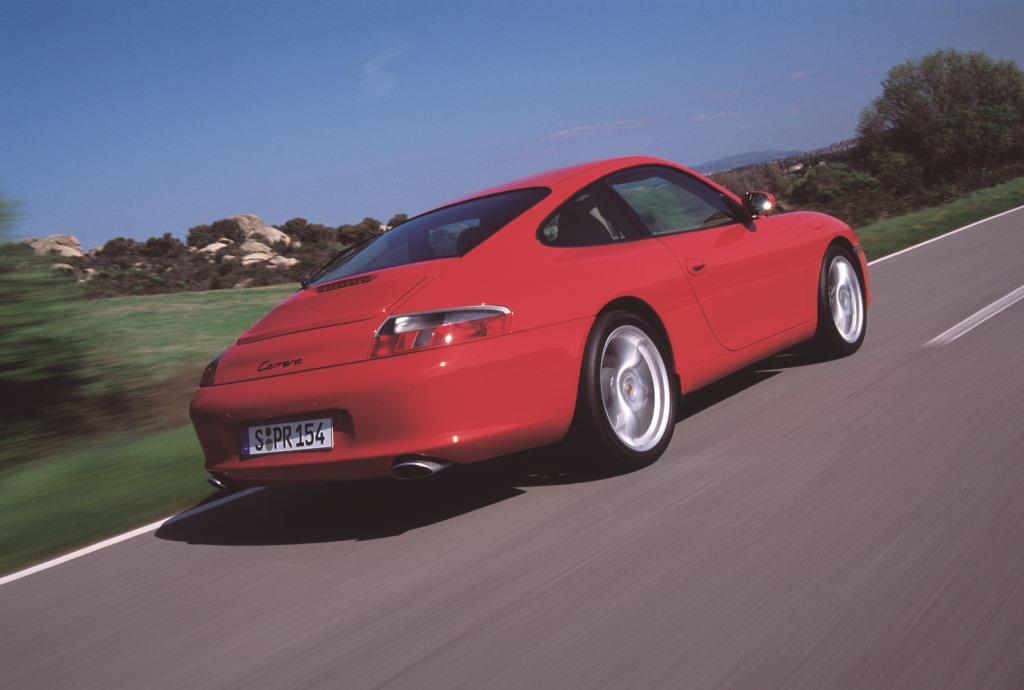
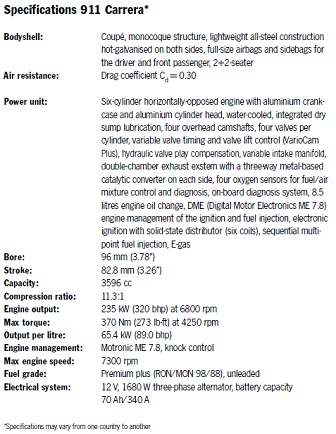
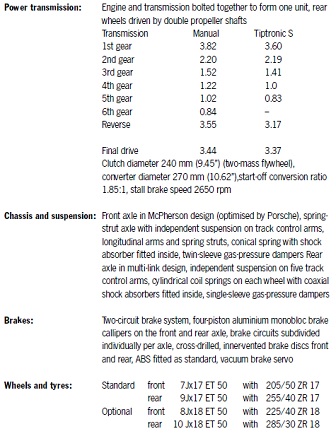
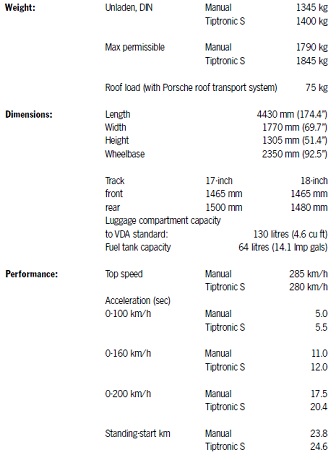
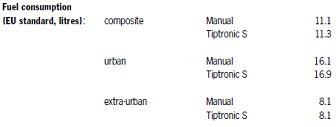

2001 911 Carrera (NA)
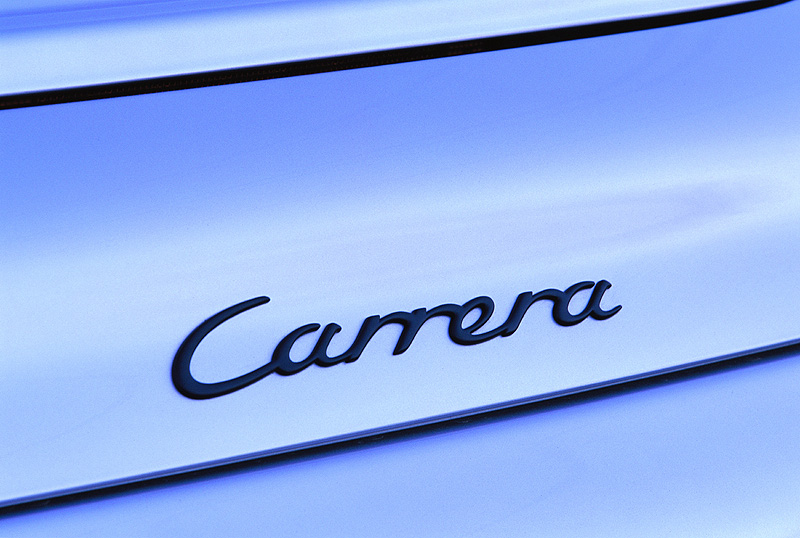
2004 911 Carrera (NA)

Porsche Press kit

Porsche Literature

Our Porsche Cars